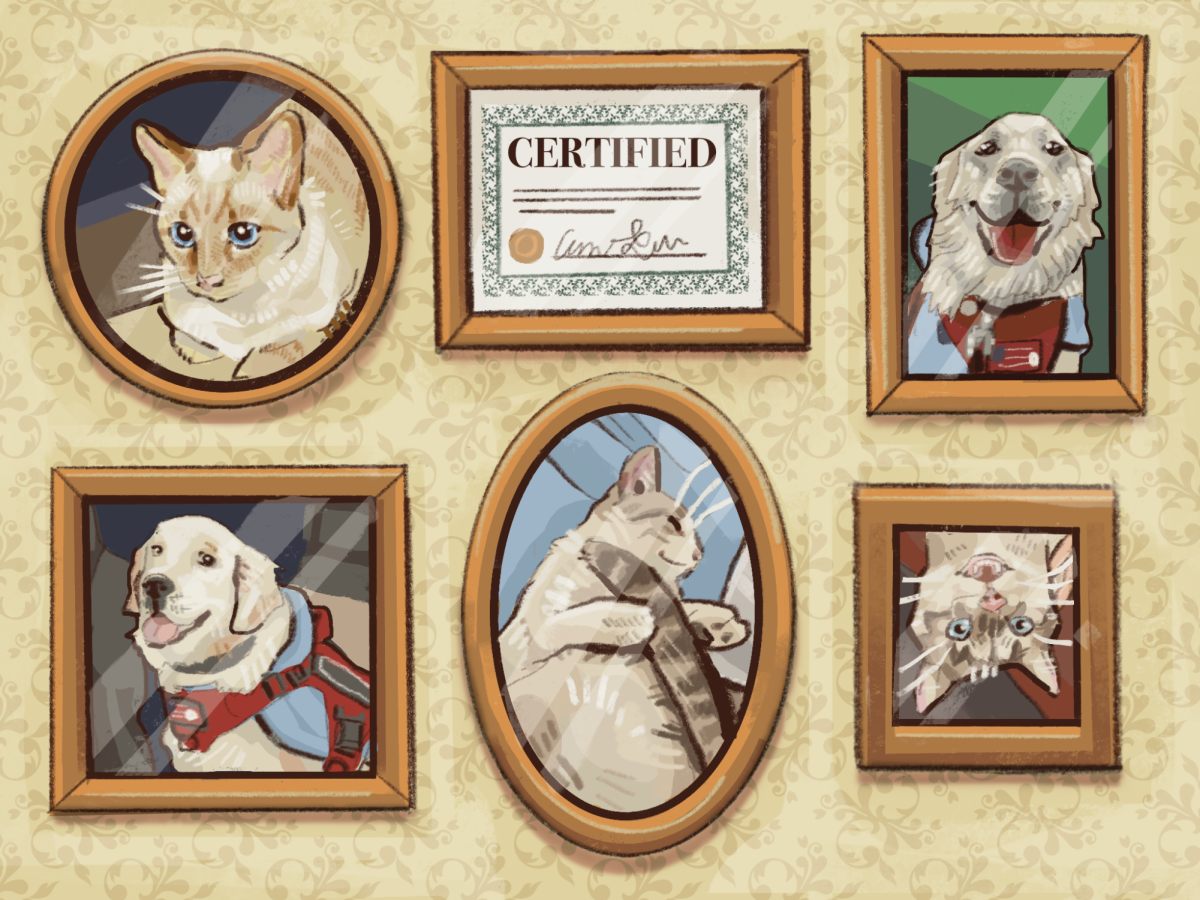Editor’s Note: This story has been updated to more accurately define emotional support animals and their roles.
When Draco gets his service dog vest put on, the English golden retriever knows it’s time to work for his owner, Kimmy Aguilar, whether it’s from his dog bed in Aguilar’s dance class or throughout campus.
Wichita State students with service animals or emotional support animals (ESAs) shared how their furry companions help them navigate life.
When Aguilar started at Wichita State last fall, her service dog, Draco, began his first day of work alongside her.
Aguilar, a freshman dance major, said she decided to get a service dog before going to college out-of-state so someone could always be ready to help her.
Service animals like Draco must perform a specific task directly related to a person’s disability, according to The Americans with Disabilities Act.
Aguilar has eosinophilic esophagitis (EoE), a mixture of vocal cord dysfunction and athlete’s heart. Growing up as a competitive dancer, she struggled with fainting, being unable to catch her breath, an unusually high heart rate and dizziness. She said in very rare cases, EoE can also lead to her having seizures.
Now, Draco watches Aguilar during dance practices, ensuring she sits when dizzy or giving her compressions when she struggles to breathe.
“I tough it out a lot. I’m very well known for that, so if I’m like, ‘Oh, let me stand up. I’m fine,’ and he’s like, ‘No, you’re not,’” Aguilar said. “He makes sure I don’t get up.”

Under the ADA, service dogs can go with people with disabilities generally anywhere in public. According to Isabel Medina Keiser, the director of the Office of Student Accommodations and Testing, students are not required to register their service animal with OSAT.
While Aguilar stressed how Draco is with her all the time and must always be prepared, she said his service dog vest helps him know when he’s “only on duty” and should focus solely on Aguilar.
“It’s like putting your jacket on for work or something,” she said.
The dancer said others’ interactions with Draco have been mostly positive, aside from a few poor encounters with less trained animals in Shocker Hall and some “typical guys” in the dining hall or in one of her fall classes who distracted Draco by calling his name.
“Just simple and easy as that, asking ‘Is he on duty?’ or ‘Is he working?’ or even the question of ‘May I pet your dog?’ … is the biggest thing you can ask of someone who has a service animal,” Aguilar said.
Emotional support animals
Draco is far from the only animal in the residence halls — Katie Austin, the director of Housing and Residence Life, said 41 ESAs and three service dogs currently live in WSU housing. This number includes dogs, cats and even a ferret.
According to the ADA National Network, ESAs provide comfort and companionship to their owners, and they provide emotional support alleviating one or more symptoms of a person’s disability. Unlike service animals, they “do not receive special training to perform tasks that help people with disabilities.”
Medina Keiser said students living with an ESA in campus housing must have documentation from a professional stating the student’s diagnosis and their need for an ESA.
While Medina Keiser said service animals are almost always dogs, ESAs can be any kind of animal.
Austin said unlike service animals, ESAs are restricted to students’ living areas.
According to Austin, the number of ESAs has increased within the last five years. OSAT notifies Housing when it approves the ESA, and then students must sign a behavioral agreement for their ESA.
“This a big responsibility, and it’s not something they should enter into lightly because it is ultimately on them to take care of that animal,” Austin said.
Mel Sharp, a junior majoring in applied drawing, said that the responsibility of taking care of her ESA, a cat named Toast, helped improve her mental health.

Following a week spent in bed and a therapist’s recommendation, Sharp decided to get Toast while living in Shocker Hall during her freshman year.
“It’s nice having a pet there that you would have to get out of bed to walk or feed or clean up after,” Sharp said. “And it really has helped me a lot.”
Sharp, who has since moved off campus, said WSU’s approval process went quickly, and her roommates and other Shocker Hall residents accepted Toast.
Sharp’s only recommendation for Shocker Hall is to have a better trash set-up so she could have more easily cleaned Toast’s litter box instead of going from her fifth-floor room to the dumpster outside.
Freshman Misty Galloway said she got her cat certified as an ESA to help her manage her social anxiety and her first year in college. She said upon receiving her therapist’s letter, her apartment complex approved Angel, a white-haired cat.

“Whenever I’m really sad or about to cry, she’s always like, ‘Ooh, what she’s doing over here? Look at me. I’m gonna be a little weirdo,’” Galloway said. “She just has this way of always knowing when I’m not feeling so great and showing up.”
Recommendations
For students interested in getting an ESA, Austin and Medina Keiser both emphasized considering the full responsibilities of caretaking for an animal, such as having plans for when students are in class or on spring break.
Medina Keiser also mentioned the importance of finding other supports than the animal, such as counseling.
“Just making sure that you’re not putting all that pressure on the emotional support animal and making sure that you’re going to give them a good home,” she said.
The Student Government Association passed a resolution in January urging for greater student accountability of ESAs in residence halls. But Austin said residents generally notify them of any animal misbehavior, and overall, owners are responsible.
“They really care for this animal as if it was their own child,” Austin said.
Students wanting to live on campus with ESA or register their service animal can go to OSAT’s website.






Elaine Jordan • Apr 15, 2024 at 12:16 pm
This is fascinating, because according to the FHA which is the federal law that allows ESAs in college dorms, the very definition of an Emotion Support Animal is an animal that provides emotional support that ” alleviates one or more identified effects of a persons DISABILITY “. So, yes, in order to have an ESA, one must have a disability.
Or do college journalists not learn to do research anymore into the background before they write stories?